

It has now become a rather standard exercise, with available
technology, to construct graphs to consider the equation
and to overlay several graphs of
for different values of a, b, or c as the other two are held
constant. From these graphs discussion of the patterns for the
roots of
can be followed. For example, if we set
for b = -3, -2, -1, 0, 1, 2, 3, and overlay the graphs, the
following picture is obtained.
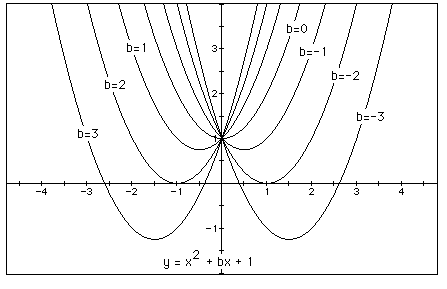
We can discuss the "movement" of a parabola as b
is changed. The parabola always passes through the same point
on the y-axis ( the point (0,1) with this equation). For b <
-2 the parabola will intersect the x-axis in two points with positive
x values (i.e. the original equation will have two real roots,
both positive). For b = -2, the parabola is tangent to the x-axis
and so the original equation has one real and positive root at
the point of tangency. For -2 < b < 2, the parabola does
not intersect the x-axis -- the original equation has no real
roots. Similarly for b = 2 the parabola is tangent to the x-axis
(one real negative root) and for b > 2, the parabola intersects
the x-axis twice to show two negative real roots for each b.
Now consider the locus of the vertices of the set of parabolas
graphed from
Show that the locus is the parabola
To show that the locus of the vertices of the set of parabolas is the parabola
we must use the vertex of the parabola and a point on the parabola. We know that the value of a in our parabola is negative because the graph opens downward. Since our parabola has the vertex of (0,1), our equation has to be in the form
where c=1. The last part of our problem is to check to see if a=-1 by substituting one point on the parabola into x and y. We know that c=1, therefore our equation has to be in the form
Lets take the point on the parabola (-1,0) and find out whether a=-1. We substitute in -1 for x and 0 for y and get the following equation.
The second step is to subtract 1 on both sides to get the following equation.
Therefore, we can say that a must equal -1. So our equation must be equal to
Generalize.
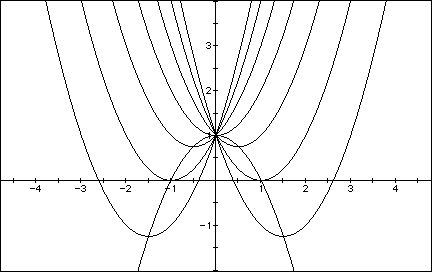
Consider again the equation
Now graph this relation in the xb plane. We get the following
graph.

If we take any particular value of b, say b = 3, and overlay
this equation on the graph we add a line parallel to the x-axis.
If it intersects the curve in the xb plane the intersection points
correspond to the roots of the original equation for that value
of b. We have the following graph.

For each value of b we select, we get a horizontal line. It is clear on a single graph that we get two negative real roots of the original equation when b > 2, one negative real root when b = 2, no real roots for -2 < b < 2, One positive real root when b = -2, and two positive real roots when b < -2.
Lets look at another graph in the xb plane. In this graph, b=2. Our equation is
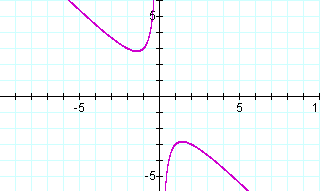
In this graph, we can also look at the roots of the equation by graphing the equation of b for any value of b. Lets look at the graph of b=3.
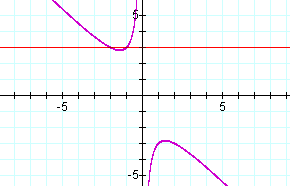
In this graph where b=3, we have two roots. We can also look at the graph where b=2.8.

In this graph where b=2.8, we have exactly one root. Therefore, we can say that for the graph of the equation
When b>2.8 and b<-2.8, we have two roots. When b=2.8 and -2.8, we have exactly one root. When b is less than 2.8 and greater than -2.8, we have no real roots. For any graph in the xb plane when a and c are positive we have the same possible roots, where part of the graph has two solutions, two points have one solution, and part has no solution. Next we will look at the cases where a and c are negative.
Consider the case when c = - 1 rather than + 1.


In this graph, we also always have two roots for b for any value of b. This is true for any graph in the xb plane where c is negative. Next lets look at an example where a is negative.
In this graph, a=-1.

From the graph, we can see that we also always have two roots for any value of b. This graph is similar to the graph where c is negative. The graph is kind of flipped over to the other side of the y-axis. This is true for any negative a in the xb plane.
Therefore, we can say that for any graph in the xb plane, when a and c are positive, we have parts with two roots, two points with one root, and parts with no roots. When a or c are negative, we always have two roots.
In the following example the equation
is considered. If the equation is graphed in the xc plane,
it is easy to see that the curve will be a parabola. For each
value of c considered, its graph will be a line crossing the parabola
in 0, 1, or 2 points -- the intersections being at the roots of
the orignal equation at that value of c. In the graph, the graph
of c = 1 is shown. The equation
will have two negative roots -- approximately -0.2 and -4.8.
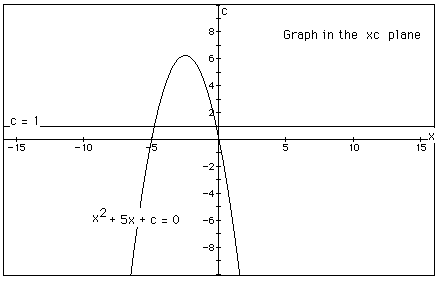
There is one value of c where the equation will have only 1
real root -- at c = 6.25. For c > 6.25 the equation will have
no real roots and for c < 6.25 the equation will have two roots,
both negative for 0 < c < 6.25, one negative and one 0 when
c = 0 and one negative and one positive when c < 0.
Next lets look at what happens in the xc plane where a and b are negative. First lets look at a case where a is negative. In this graph, a=-1. Therefore, our equation is
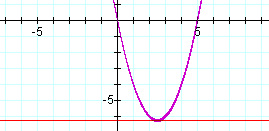
In this graph where a=-1, our parabola opens up instead of down. It still has the same shape as the previous graph. When c=-6.25, we have exactly one root. When c>-6.25, we have two roots, and when c<-6.25, we have no roots. When 0>c>-6.25, we have two positive roots. When c=0, we have one positive root and one 0. When c>0, we have one positive and one negative root. Next lets look at the case where b is negative.
In this graph b=-5, therefore our equation is
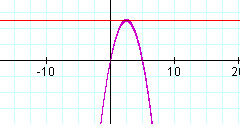
In this graph where b=-5, our graph opens down. When c=6.25, we have exactly one root. When c>6.25, we have no roots, and when c<6.25, we have two roots. From 6.25>c>0, we have two positive roots. When c=0, we have one positive root and one 0 root. When c<0, we have one positive root and one negative root.
Therefore, we can say that for any graph in the xc plane; we will always get a parabola. In this parabola, we will always have a point where we will have one root. We will have a set of numbers where we have no roots. We will have a set of numbers where we have two roots.
Graphs in the xa plane
Consider the graph of the equation
If we graph this equation in the xa plane, we get the following graph.

In this graph, we have two curves that the limit of is the x-axis as they go outward. On the curve, we can graph the equation where a equals a number to show the roots of the equation in the xa plane. Lets first graph the equation a=0.1.
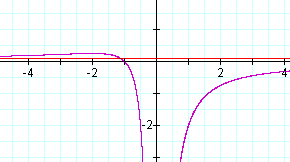
In this graph, we have two roots. If we graph the equation a=0.25, we have exactly one root.
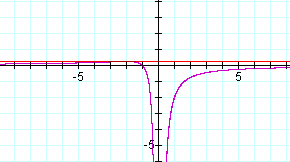
Therefore, we can see that for this graph in the xa plane. When a=0.25, we have exactly one root. When a>0.25, we have no roots. When a<0.25, we have exactly two roots. Next lets look at the cases where a and b are negative.
First lets look at the graph where b=-1. Our equation will be
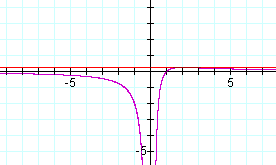
This graph is similar to the first graph except that it has been flipped over the y-axis. The two curves still have the x-axis as their limits as they go outward. We have overlaid the graph of the equation a=0.25. This line shows us that we have exactly one root at the point a=0.25. We can also say that in this graph when a>0.25, we have no roots. When a<0.25, we have exactly two roots. Therefore when b is negative, it does not effect the number of roots, but the graph has been flipped over the y-axis.
Next, lets consider the case when c is negative. In this graph, c=-1. Therefore our equation is
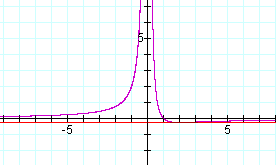
We also have the same shape in this graph. This time our graph has been rotated over the x-axis and over the y-axis. Our graph two curves still have the x-axis as their limit as they go outward. We have overlaid the equation a=-0.25 onto the graph. This shows us that we have exactly one root at this point on the xa plane. When a<-0.25, we have no roots. When a>-0.25 we have two roots.
Therefore, we have seen that in the xa plane. Our graphs of the equation in the form
for different values of b and c, the curve of the graph is the same. In all of the graphs, we have part with no roots, one root, and two roots.
Conclusion:
We have looked at graphs in the xb, xc, and xa plane. In each plane, the equation
acts differently. We have seen that in each plane when a, b, or c are negative, it effects the roots of the equation. We have also seen that in each plane, there are parts of the graph that have two roots, one root, or no roots.